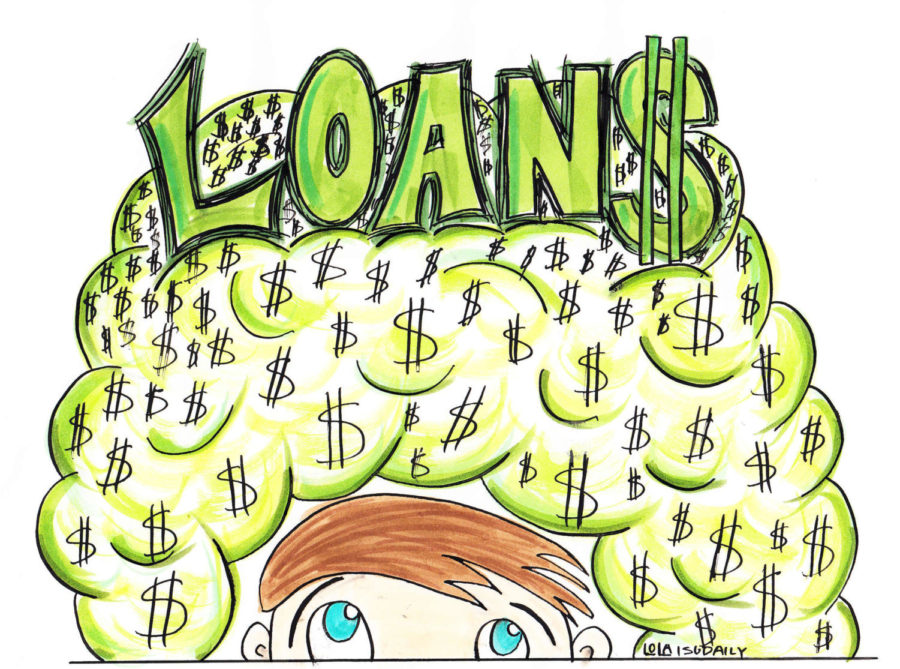The Biden Administration plans to provide assistance to college students
In 2013, USA Today ranked the state of Iowa as No. 6 for schools with the most student debt, with the 2013 average student loan debt piling up to nearly $30,000. About 72 percent of college students in the state of Iowa take out student loans.
January 26, 2021
You might not have to worry about spending too much money on your Starbucks coffee anymore — President Joe Biden is trying to help college students with student loan forgiveness and increased Pell Grants.
The Biden Administration plans to assist college students during the pandemic in multiple ways. From pausing student loan payments to canceling student loan debt, college students might find paying for college easier.
“It is not uncommon for a newly elected president to implement agendas that were supported by those who supported them, in this case, college students,” said Mack Shelley, department chair of political science.
On Thursday, Biden requested that the Education Department extended federal student loan payments forbearance until Sept. 30.
“In my opinion, the suspension of federal student loan payments is a much-needed measure for all students during the pandemic,” said Sophie Shoultz, a graduate teaching assistant in the political science department.
This continuation of relief gives 42 million student loan borrowers, according to Forbes, a break from their monthly payments and accruing interest.
“For students currently enrolled, this doesn’t mean a whole lot now because you usually don’t start paying them until you graduate,” said Mady Jones, a political science graduate teaching assistant.
Jones said she is excited about the pause because it means she can save up more money and pay off her student loans in larger amounts.
Zack Bonner, a lecturer of political science, said deferring student loan payments helps a lot of individuals who are struggling during the pandemic and it allows them to have funds to pay rent, buy food, etc. without worrying about paying loan payments.
This pause on student loans only applies to federal student loans, meaning that only those attending or having attended public colleges or universities will be able to pause their student loans.
“Since the order does not extend to loans that are held privately, it’s not necessarily relief for students and recent graduates across the board,” Shoultz said. “I think this is a necessary relief effort while we are in the midst of the pandemic.”
The Biden Administration is also looking into other ways to help make higher education more affordable. One way is forgiving student loans, which has been a topic of discussion in recent years.
The national student debt total recently hit $1.7 trillion, according to Forbes. Student debt is tracking to rise in years to come, leaving a financial burden on college students.
During Biden’s campaign, he released his proposal for up to $10,000 student loan forgiveness.
“I think by trying to cancel some or all federal student loan debt is seen by many as a way of freeing up an entire generation from an overwhelming burden,” Bonner said.
Bonner said a reason canceling some or all student loans is a topic of discussion is because the assumption is that if graduated students aren’t spending most of their paychecks on student loan payments, then they will end up putting more money into the economy.
Biden has proposed his plan on student loan forgiveness, but it is still uncertain when it would be proposed to Congress and whether it will be passed.
Although Democrats have a majority in the U.S. Senate and the House of Representatives, it still might be tricky to get a large debt relief bill passed; there would have to be little or no Democrats who defect, Shelley said.
“I think it will be interesting to see how willing Congress is to work with each other in pushing forward many of the Biden Administration policies, with the slim margins the Democrats have in each chamber,” Bonner said.
Another avenue that the Biden Administration is looking into is increasing Pell Grants.
Many college students from low-income families receive Pell Grants. Students who qualify for it in 2020-21 can receive a maximum of $6,345. Biden plans to double the grant amount.
“I think increasing Pell Grants is a great idea and canceling student debt is not,” said Patrick Redmond, a political science graduate teaching assistant. “We ought to be looking at not necessarily increasing the quantity of students but rather the quality of students. Universities are not for everyone, and pigeonholing high schoolers into thinking that college is the only option for their future is disastrous for this state and country as a whole.”
Details for Biden’s plan to double the Pell Grant maximum amount has not been released.
Biden has also outlined a plan to make public colleges and universities tuition-free for households with incomes below $125,000, as well as making community college tuition-free.
Bonner said he doesn’t see an easy way for pushing for free college in the near future. It would require a lot of give-and-take at the state and national levels.
With Biden’s plans for higher education, public and community college might become more affordable.
“Making college more affordable and accessible to a wider population is a great thing and would probably boost enrollment levels to a good extent,” Bonner said. “I think helping interested individuals be able to afford college would be a nice boost to enrollment, especially at the community college level.”
Although the Biden Administration has multiple plans to help out college students, there is still speculation on how his plan will affect the economy in the long run.
“I think Biden’s plan pursues a lot of issues that are either fringe or counterproductive to positive educational policy,” Redmond said. “I think the best federal policy when it comes to higher education is a relatively hands-off policy and to allow states to curate curriculum to best suit the needs of their respective communities.”







